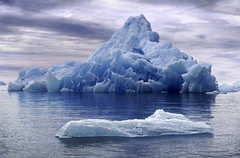
In 2004, a scientific crew braced the cold and the odds to extract a sediment core from 400m below the seabed of the Arctic Ocean. The core showed that Fifty-five million years ago, deep in the Eocene, the North Pole was ice-free and enjoying tropical temperatures. It also told us that the temperature of the ocean was 20C, instead of the coolish –1.5C we see today, a truth that is hard to imagine today with all the hype around global warming -- even from bright folks like Al Gore.
The bottom end of that core helped explain the fossils found at Eocene sites around British Columbia, species commonly seen in more tropical environments today. The warmer temperatures seen at McAbee and around the globe were recorded in the core sample and reveal evidence for a global event known at the Palaeocene-Eocene Thermal Maximum. Back in the Eocene, a gigantic emission of greenhouse gases was released into the atmosphere and the global temperature warmed by about 5C. 
When you look at graphs proving or disproving global warming, look closely at the time scale. Also remember that the term, "in recorded history" is a red flag when it comes to geologic time and the big picture. Humans have been around for a mere blink of the Earth's history and only recording data for a miniscule portion of that. The graph here shows the timescale back to 65 million years.
For the hotbed of the Earth's history, we look to the Eocene, around 50 million years. While the bookends of the geologic time scale slide back and forth a wee bit, the current experts in the geologic community set the limits to be 33.9 +_ 0.1 to 55.8 +_ 0.2 million years ago.
The fossil record tells us that this part of British Columbia and much of the Earth was significantly warmer around that time, so warm in fact that we find temperate and tropical plant fossils in areas that now sport plants that prefer much colder climes, or as is the case in the Arctic, snow and ice.
The Okanagan Highlands is an area centred in the Interior of British Columbia, but the term is used in a slightly misleading fashion to describe an arc of Eocene lakebed sites that extend from Smithers in the north, down to the fossil site of Republic Washington. The grouping includes the fossil sites of Driftwood Canyon, Quilchena, Allenby, Tranquille, McAbee, Princeton and Republic. 
These fossil sites range in time from Early to Middle Eocene, and the fossils they contain give us a snapshot of what was happening in this part of the world. While the area around the Interior of British Columbia was affected. McAbee was not as warm as some of the other Middle Eocene sites, a fact inferred by what we see and what is conspicuously missing. We see spiders, dragonflies, fish and many, many march flies.
In looking at the plant species, it has been suggested that the area of McAbee had a more temperate climate, slightly cooler and wetter than other Eocene sites to the south at Princeton, British Columbia and Republic and Chuckanut, Washington. Missing are the tropical Sabal (palm), seen at Princeton and the impressive Ensete (banana) and Zamiaceae (cycad) found at Republic and Chuckanut, Washington.
While we are the likely culprits of much of the warming of the Arctic today, natural processes operating in the not too distant past have also resulted in significant temperature fluxuations on a world-wide scale.
Global Warming: All Lies, Err Hype?





Comments